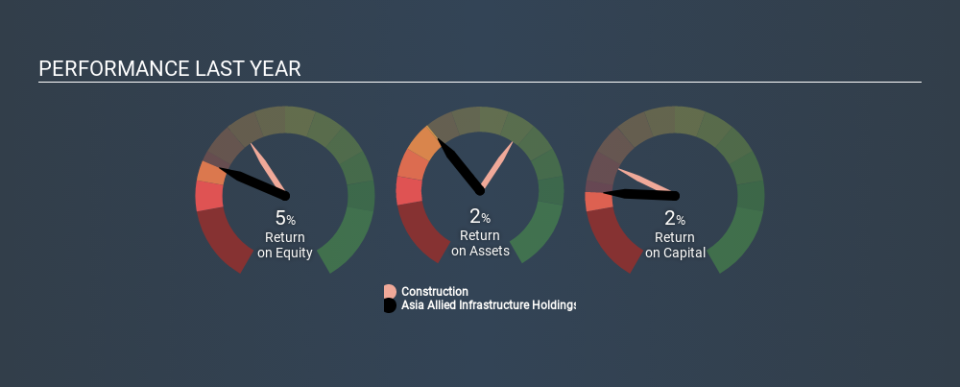Should Asia Allied Infrastructure Holdings Limited’s (HKG:711) Weak Investment Returns Worry You?

Today we'll look at Asia Allied Infrastructure Holdings Limited (HKG:711) and reflect on its potential as an investment. To be precise, we'll consider its Return On Capital Employed (ROCE), as that will inform our view of the quality of the business.
First up, we'll look at what ROCE is and how we calculate it. Then we'll compare its ROCE to similar companies. Finally, we'll look at how its current liabilities affect its ROCE.
Understanding Return On Capital Employed (ROCE)
ROCE measures the amount of pre-tax profits a company can generate from the capital employed in its business. All else being equal, a better business will have a higher ROCE. In brief, it is a useful tool, but it is not without drawbacks. Renowned investment researcher Michael Mauboussin has suggested that a high ROCE can indicate that 'one dollar invested in the company generates value of more than one dollar'.
So, How Do We Calculate ROCE?
Analysts use this formula to calculate return on capital employed:
Return on Capital Employed = Earnings Before Interest and Tax (EBIT) ÷ (Total Assets - Current Liabilities)
Or for Asia Allied Infrastructure Holdings:
0.015 = HK$59m ÷ (HK$8.5b - HK$4.5b) (Based on the trailing twelve months to September 2019.)
So, Asia Allied Infrastructure Holdings has an ROCE of 1.5%.
See our latest analysis for Asia Allied Infrastructure Holdings
Does Asia Allied Infrastructure Holdings Have A Good ROCE?
One way to assess ROCE is to compare similar companies. We can see Asia Allied Infrastructure Holdings's ROCE is meaningfully below the Construction industry average of 12%. This performance could be negative if sustained, as it suggests the business may underperform its industry. Putting aside Asia Allied Infrastructure Holdings's performance relative to its industry, its ROCE in absolute terms is poor - considering the risk of owning stocks compared to government bonds. Readers may wish to look for more rewarding investments.
Asia Allied Infrastructure Holdings's current ROCE of 1.5% is lower than 3 years ago, when the company reported a 4.3% ROCE. Therefore we wonder if the company is facing new headwinds. The image below shows how Asia Allied Infrastructure Holdings's ROCE compares to its industry, and you can click it to see more detail on its past growth.
When considering ROCE, bear in mind that it reflects the past and does not necessarily predict the future. Companies in cyclical industries can be difficult to understand using ROCE, as returns typically look high during boom times, and low during busts. ROCE is only a point-in-time measure. How cyclical is Asia Allied Infrastructure Holdings? You can see for yourself by looking at this free graph of past earnings, revenue and cash flow.
What Are Current Liabilities, And How Do They Affect Asia Allied Infrastructure Holdings's ROCE?
Current liabilities are short term bills and invoices that need to be paid in 12 months or less. Due to the way ROCE is calculated, a high level of current liabilities makes a company look as though it has less capital employed, and thus can (sometimes unfairly) boost the ROCE. To counter this, investors can check if a company has high current liabilities relative to total assets.
Asia Allied Infrastructure Holdings has total assets of HK$8.5b and current liabilities of HK$4.5b. Therefore its current liabilities are equivalent to approximately 54% of its total assets. This is a fairly high level of current liabilities, boosting Asia Allied Infrastructure Holdings's ROCE.
Our Take On Asia Allied Infrastructure Holdings's ROCE
Asia Allied Infrastructure Holdings's ROCE is also pretty low (in absolute terms), making the stock look unattractive on this analysis. You might be able to find a better investment than Asia Allied Infrastructure Holdings. If you want a selection of possible winners, check out this free list of interesting companies that trade on a P/E below 20 (but have proven they can grow earnings).
For those who like to find winning investments this free list of growing companies with recent insider purchasing, could be just the ticket.
If you spot an error that warrants correction, please contact the editor at editorial-team@simplywallst.com. This article by Simply Wall St is general in nature. It does not constitute a recommendation to buy or sell any stock, and does not take account of your objectives, or your financial situation. Simply Wall St has no position in the stocks mentioned.
We aim to bring you long-term focused research analysis driven by fundamental data. Note that our analysis may not factor in the latest price-sensitive company announcements or qualitative material. Thank you for reading.

